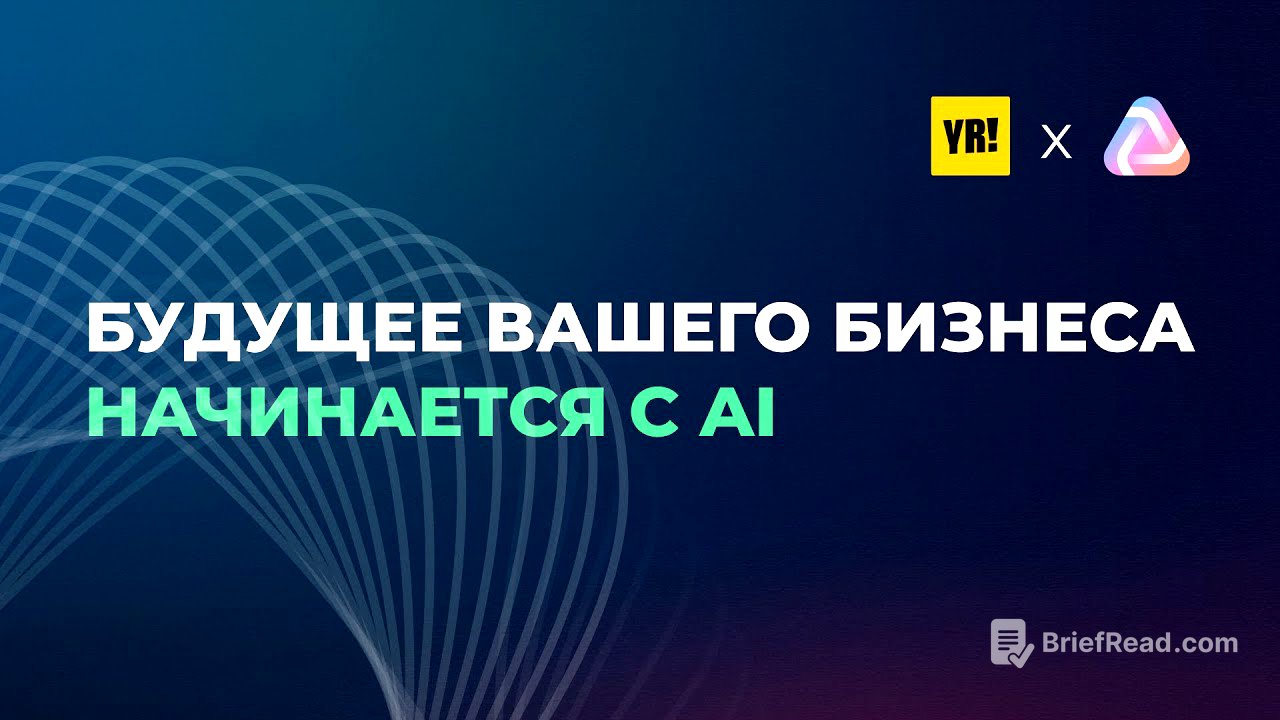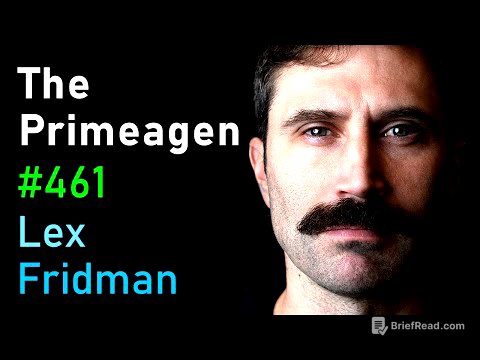TLDR;
This YouTube video transcript features a conference on AI, focusing on practical applications, investment opportunities, and potential risks. Speakers share their experiences and insights on how AI is changing various industries, from marketing and sales to cybersecurity and lending. The conference aims to inspire attendees to explore AI tools and strategies for their own businesses, while also being mindful of the ethical and security challenges that come with this technology.
- AI investment opportunities
- Practical AI applications in business
- Ethical and security risks of AI
Intro and Welcome [0:01]
The host welcomes the audience to a conference focused on AI, emphasizing the importance of sharing practical experiences and discussing real-world applications of AI in business. The goal is to move beyond theoretical discussions and news headlines to understand how AI is currently impacting various industries. The host expresses a desire to create an engaging and interactive experience, encouraging attendees to participate actively and share their own insights.
About the Host and Conference Origins [2:30]
The host introduces himself as an entrepreneur and investor with experience in venture capital. He explains that the idea for the conference came from a conversation with an investor in Dodo Pizza, who emphasized the importance of investing in things that "cannot not happen." The host believes that AI falls into this category and is already transforming the world. The conference aims to showcase how portfolio projects are using AI to disrupt their respective niches and achieve significant results.
Yellow Rox Fund and AI's Impact [6:01]
The host discusses the Yellow Rox Fund's investment strategy, which focuses on projects that leverage AI to disrupt their industries. He emphasizes that the benefits of AI should be accessible to all entrepreneurs, not just those in the venture capital space. The host shares his personal experience of using AI tools like GPT and highlights how AI can simplify tasks such as creating landing pages and marketing materials. He also mentions the importance of creating a community to share knowledge and experiences related to AI.
Conference Format and Expected Outcomes [10:49]
The host outlines the conference format, which includes presentations from four speakers followed by Q&A sessions. He expresses a desire for attendees to leave with a "wow effect" and a motivation to experiment with new AI tools and approaches in their own businesses. The host also mentions the use of AI tools within the Yellow Rox Fund to streamline processes such as reviewing thousands of transactions each year. He concludes by emphasizing that businesses that have not yet embraced AI are already falling behind and risk becoming obsolete.
Yellow Rocks Fund Overview [14:35]
Sergey Bogdanov, the founder of Yellrock, provides an overview of the fund, mentioning that they manage several funds and have made 39 investments in the current fund. He highlights that almost all of their portfolio companies are related to AI, using it in various applications. Bogdanov emphasizes that this is a golden time for investing in AI companies due to the technological wave and potential for market redistribution. He also mentions various activities they conduct for entrepreneurs and investors, such as open space events and trips to different locations.
Investment Focus and Examples [16:51]
Bogdanov details the fund's investment focus on early-stage companies, particularly those at the pre-seed and seed stages. He mentions that they can invest up to $2 million in a company and have participated in deals exceeding $10 million. Bogdanov provides examples of companies they have invested in, such as an AI couples therapist and an AI Kupayla for university students. He also promotes a Telegram bot where they post information about their transactions and invites listeners to join their upcoming events in the Azores and Italy.
Speaker Introduction - Ivan Shkvarun [21:11]
Bogdanov introduces Ivan Shkvarun, the founder of Social Links, as a leader in innovation and technology in the OSINT (Open Source Intelligence) market. He mentions that Social Links helps find information about individuals or companies using open data on the internet. Bogdanov announces that Shkvarun will be speaking on the "Dark Side of Artificial Intelligence" and the hidden threats that AI can pose to businesses.
Dark Side of AI - Introduction and Game [21:54]
Ivan Shkvarun thanks the organizers and confirms the value of cooperating with Yellrock. He introduces the topic of the dark side of AI, explaining that while AI is often praised for its benefits, it also carries significant risks. Shkvarun shares that criminals are using AI in sophisticated ways. He starts with a game where the audience tries to identify real vs AI-generated people.
AI-Generated People and Deepfakes [25:53]
Shkvarun reveals that 80% of people cannot identify modified images. He shows examples of AI-generated models earning significant income and deepfakes used in scams. One example is a military colonel using a generated front to scam a woman for hundreds of thousands of pounds. Shkvarun emphasizes that the ability to distinguish between real and fake is rapidly decreasing.
Bright Side of AI and Business Applications [30:04]
Shkvarun transitions to the bright side of AI, highlighting its potential in various business applications. He mentions AI assistants, predictive analytics, marketing, routine tasks, and research. He provides examples such as McDonald's using AI to predict equipment breakdowns, eBay using AI to optimize marketing for billions of items, and Sephora using a chatbot to increase customer engagement and sales.
Risks of AI and Disinformation [36:58]
Shkvarun emphasizes that AI helps collect personal data, which carries risks. He highlights fakes and disinformation as the number one risk for humanity, according to the World Economic Forum. Other risks include cybercrime, data leakage, discrimination, and loss of control over the brand. He provides examples such as fake photos promoted by media, Coca-Cola's AI-generated ad being rejected by viewers, and criminals using AI to generate multi-move combinations for financial fraud.
Examples of AI Risks and Brand Loss [40:36]
Shkvarun shares examples of AI-related risks, including fake photos promoted by media outlets and Coca-Cola's AI-generated ad being rejected by viewers. He also discusses a case where criminals used AI to generate a multi-move combination to steal $25 million from a company. Additionally, he mentions a case where criminals launched a platform using Elon Musk's brand to promote fraudulent investments.
Recommendations for Mitigating AI Risks [44:10]
Shkvarun provides five recommendations for mitigating AI risks: marking AI-generated content, using tools for protection against digital risks, media verification, training employees, and understanding that AI can be used against you. He highlights Open AI's investment in Adaptive, a company that provides training courses in cybercriticism. Shkvarun concludes by emphasizing the importance of curiosity and the need to be on the bright side of AI by understanding the dark side.
Q&A with Ivan Shkvarun [49:50]
The Q&A session begins with a question about projects that develop tools for protection against fraud based on reputation mechanisms. Shkvarun discusses methods and tools in the Digital Risk Protection area. He also addresses the challenges of predicting and preventing fraud, emphasizing the need for quick takedowns and monitoring of similar domains. The discussion touches on the constant struggle between AI and anti-AI, and the importance of strengthening human functions in the face of technological advancements.
Insights and Transition to Next Speaker [58:31]
The host summarizes the key takeaways from Ivan Shkvarun's presentation, highlighting the dominance of the criminal world in using AI for malicious purposes. He then transitions to the next speaker, Roma, describing him as a serial entrepreneur with a superpower in marketing and sales. The host mentions Roma's experience in building large systems on sales and using AI to improve efficiency.
Introduction to Roma's Presentation [1:01:12]
Roma begins by agreeing with the host's point that a lot has changed in the last two years, particularly in marketing and sales. He emphasizes the potential of AI and agents to create cool processes and overcome human factors. Roma mentions that he is making a school in Germany that teaches migrants different professions, using a GPT copy-pilot to build personalized content for each student.
AI-Powered Content Creation and Distribution [1:03:39]
Roma discusses the importance of skills in using neural networks and constructing agents. He believes that companies with few people but strong AI orchestration skills will have a competitive advantage. Roma shares a case study on vertical video creation for TikTok, YouTube, and Instagram, explaining the methodology of trendwing, transcribing content, and using parameters to produce reels. He details the challenges of this process and how AI agents can automate it.
Automating Reel Creation with AI Agents [1:09:11]
Roma explains how AI agents can automate the process of creating reels, including analytics, script generation, and video creation. He mentions using Nathan for workflow management and various services like RIT Revit AI, 11 Labs, and Igen for video generation, animation, audio synthesis, and avatar creation. Roma shares that this process takes about 20-30 minutes per video, compared to several hours manually.
Cost Savings and Content Strategy [1:13:42]
Roma highlights the cost savings of using AI for content creation, estimating a cost of $10-12 per video compared to $200-300 manually. He emphasizes the ability to test more hypotheses and build quality content on stream. Roma mentions using a mix of live and AI-generated content and spending about $1,000 per month on their content factory. He also shares that they have reels with 300-500,000 views thanks to this methodology.
AI-Powered Banner Analysis and Generation [1:17:50]
Roma discusses another application of AI in analyzing and generating advertising banners. He explains how he broke down the banner creation process into small steps and identified the cognitive distortions of targetologists and designers. Roma then describes how AI can be used to categorize banners, analyze their performance, and generate new banners based on working objects.
Automating Banner Creation with GPT Chat [1:25:12]
Roma details how GPT Chat can automate the process of object analysis and creative generation, eliminating the need for manual technical requirements. He mentions using GPT Chat to recognize objects in pictures, generate prompts for Midjourney, and create banners. Roma also discusses using data from customer research and competitor analysis to inform creative decisions.
AI-Powered Sales Department and Script Optimization [1:29:57]
Roma explains how AI can be used to monitor the work of the sales department, providing daily reports on employee performance and identifying areas for improvement. He emphasizes the cost savings and efficiency gains from using AI OKK (quality control department). Roma also mentions that the sales script becomes a megap bastard, allowing for data-driven optimization and the use of successful sales techniques in creative works.
Q&A with Roma and Key Insights [1:34:28]
The host asks about the effectiveness of AI-generated content compared to human-created content. Roma estimates that AI content is about 30% less effective but believes it is a matter of time before the quality improves. He emphasizes the ability to test more hypotheses and achieve explosive views with a scientific approach. The host highlights the importance of managing AI systems and the potential for humans to become guides for AI in the real world.
Transition to Next Speaker - Denis Shiryaev [1:37:41]
The host transitions to the next speaker, Denis Shiryaev, known for his rare appearances and interesting topics. He mentions that Denis will share how they hacked SEO and generated a huge amount of traffic without investing in marketing. The host notes that this topic aligns with a request for a similar topic to be discussed on autopath.
Introduction to Nerolav and Business Strategy [1:38:53]
Denis Shiryaev begins by correcting the host, stating that they generate all traffic, not just targeted traffic. He introduces Nerolav, a company that started in 2021 as an early-stage startup on Generative AI. Shiryaev explains that they chose to remain bootstrapped because they believe AI will be a matter of time and they want to avoid hype trains. He emphasizes the importance of marketing over technical complexity and the ability to react and change direction quickly.
Evolution of Nerolav and Focus on Marketing [1:42:18]
Shiryaev discusses the evolution of Nerolav from an R&D laboratory to a company focused on long-term existence. He explains that they shifted their investment from R&D to building a system that scales and automatically attracts new clients. Shiryaev emphasizes that marketing is more important than technical complexity and that the road from idea to MVP has become very short.
Traffic Generation System and Google Trends [1:46:08]
Shiryaev details their traffic generation system, which involves agents periodically checking Google Trends and Ahres SR to identify trending ideas. These ideas are then turned into prompts and landing pages. He mentions that they target the entire internet but filter out certain types of content, such as pornographic content. Shiryaev also discusses their system for user-generated content, where users can generate images and text for free.
User-Generated Content and AI-Powered Interface [1:51:13]
Shiryaev explains how their system allows users to generate content, which then helps them attract more traffic. He mentions that they are working on an AI-powered interface that understands the user's request and collects the necessary tools to fulfill it. Shiryaev emphasizes the importance of serving two types of clients: those who come from Chat GPT and those who come directly to their site.
Monetization and Programmatic Advertising [1:55:31]
Shiryaev discusses how they monetize their traffic by serving content creators and providing simple tools for text, video, pictures, and audio editing. He also mentions their plans to explore programmatic advertising and monetize the traffic they can buy. Shiryaev explains their model for noise detection, which identifies users who are likely to pay and provides them with special invitations and discounts.
Traffic Sources and High Intention Model [1:57:51]
Shiryaev explains that their traffic comes from their high domain rating and Google's algorithm. He mentions that they have confidential relations with Google and that their system is designed to filter out garbage traffic. Shiryaev also discusses their high intention model, which evaluates incoming visitors and generates an interface for them on the site.
Business Model and Channel Promotion [2:02:31]
Shiryaev explains that they make money by serving the content of creators and providing tools for various modalities. He promotes his Telegram channel, Denissi, where he shares his experiments and experiences. Shiryaev also discusses his early involvement in Generative AI and his efforts to maintain goodwill by writing from an expert position.
Q&A and Transition to Next Speaker [2:08:45]
The host expresses his appreciation for Denis's presentation and highlights the impressive achievement of 5 million users with zero marketing budget. He then transitions to the next speaker, Sasha Makarov, mentioning that Sasha will share insights on the limitations of AI and where it doesn't work well. The host also emphasizes the importance of finding a symbiosis between humans and AI.
Introduction to Getmo and Lending Business [2:09:52]
Sasha Makarov introduces Getmo, a company engaged in lending to small and microbusinesses in Southeast Asia. He explains that they built their business around the full cycle of working with borrowers, from onboarding to credit portfolio management. Makarov mentions that they are noticeably better than competitors in managing credit risk and operating profitability.
Initial Focus on E-Commerce and Disappointment [2:15:21]
Makarov discusses their initial focus on e-commerce businesses with clear digital footprints. He explains that they collected data from various marketplaces and tried to build a strong model for credit decisions. However, they were disappointed because the data was often flat, not well-filled, and difficult to compare across different sources.
Shift to Traditional Credit Analysis [2:19:45]
Makarov explains that they decided to step back and build up their credit politics using traditional methods, collecting documents and analyzing them manually. He mentions that they built a back office to help credit institutions work with these documents and make credit decisions. Makarov emphasizes that credit analysis is not data science but a detective story.
Experimenting with GPT and User Feedback [2:25:21]
Makarov discusses their experiment with using GPT to automate credit analysis. He explains that they had instructions and examples of loan applications and added a chat interface to their product. However, the reaction from users was negative, as they found it difficult to trust the model's judgments and preferred to check every fact manually.
Focus on Automating Small Nodes and Human Marking [2:29:34]
Makarov explains that they shifted their focus to automating small nodes in the credit analysis process, such as analyzing photos of stores. He emphasizes the importance of human marking and adapting the models to the context of their business. Makarov also highlights the value of user trust and clear processes.
Product as a Trojan Horse and Operating Efficiency [2:35:33]
Makarov discusses how their product became a Trojan horse, allowing them to collect data and understand how users interact with each other. He emphasizes that this infrastructure allows them to achieve operating efficiency and profitability. Makarov concludes by sharing his belief that models are commodities and that the only competitive advantage is investing early in data and expertise.
Key Takeaways and New Business Branch [2:41:59]
Makarov summarizes his key takeaways, emphasizing the importance of user trust, clear processes, and data. He also mentions their new business branch, which is focused on helping others with lending and providing a turnkey format of their product. Makarov invites interested individuals to discuss this further.
Q&A and Closing Remarks [2:42:59]
The Q&A session begins with a question about automating support with clients. Makarov explains that they don't automate support much because their onboarding process is effective enough. He also mentions that they sometimes talk to clients in person to ensure it's not fraud. The host thanks Sasha for the story and highlights the passion and depth he brings to his business. The host then announces the end of the official part of the conference and the beginning of the auto party.









